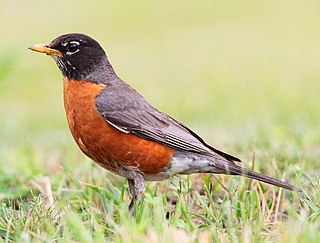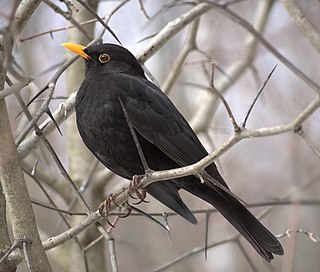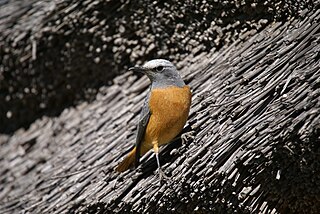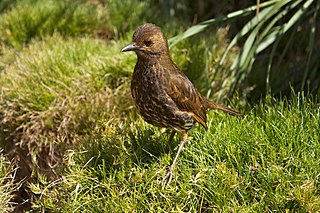
The American robin is a migratory bird of the true thrush genus and Turdidae, the wider thrush family. It is named after the European robin because of its reddish-orange breast, though the two species are not closely related, with the European robin belonging to the Old World flycatcher family. The American robin is widely distributed throughout North America, wintering from southern Canada to central Mexico and along the Pacific coast.

The thrushes are a passerine bird family, Turdidae, with a worldwide distribution. The family was once much larger before biologists reclassified the former subfamily Saxicolinae, which includes the chats and European robins, as Old World flycatchers. Thrushes are small to medium-sized ground living birds that feed on insects, other invertebrates and fruit. Some unrelated species around the world have been named after thrushes due to their similarity to birds in this family.

The song thrush is a thrush that breeds across the West Palearctic. It has brown upper-parts and black-spotted cream or buff underparts and has three recognised subspecies. Its distinctive song, which has repeated musical phrases, has frequently been referred to in poetry.

The Old World flycatchers are a large family, the Muscicapidae, of small passerine birds restricted to the Old World, with the exception of several vagrants and two species, bluethroat and northern wheatear, found also in North America. These are mainly small arboreal insectivores, many of which, as the name implies, take their prey on the wing. The family is relatively large and includes 351 species which are divided into 54 genera.

True thrushes are medium-sized mostly insectivorous or omnivorous birds in the genus Turdus of the wider thrush family, Turdidae. The genus name Turdus is Latin for "thrush". The term "thrush" is used for many other birds of the family Turdidae as well as for a number of species belonging to several other families.

The genus Catharus is an evolutionary clade of forest-dwelling passerine birds in the family Turdidae (thrushes), commonly known as nightingale-thrushes. The extant species are widely distributed across the Americas and are descended from a common ancestor that lived 4–6 million years ago. Most of the species are shy of humans, seldom leaving the cover of dense forest vegetation, where their activities are hidden from view. Thus, many fundamental aspects of their biology and life histories are poorly known.

The rock thrushes, Monticola, are a genus of chats, medium-sized mostly insectivorous or omnivorous songbirds. All are Old World birds, and most are associated with mountainous regions.

The whistling thrushes comprise a genus Myophonus of the Old World flycatcher family Muscicapidae.

The bluebirds are a North American group of medium-sized, mostly insectivorous or omnivorous birds in the order of Passerines in the genus Sialia of the thrush family (Turdidae). Bluebirds are one of the few thrush genera in the Americas.

The cochoas are medium-sized frugivorous, insectivorous and molluscivorous birds in the genus Cochoa. Their bright contrasting plumage patterns, sexual dimorphism and feeding habits made their systematic position difficult to ascertain in early times, Richard Bowdler Sharpe placed them with the Prionopidae in 1879 while many considered them as some kind of aberrant thrush. The genus was previously included in the Old World flycatcher family Muscicapidae but molecular phylogenetic studies have shown that it is more closely related to the thrush family Turdidae.

The blue rock thrush is a species of chat. This thrush-like Old World flycatcher was formerly placed in the family Turdidae. It breeds in southern Europe, northwest Africa, and from Central Asia to northern China and Malaysia. The blue rock thrush is the official national bird of Malta and was shown on the Lm 1 coins that were part of the country's former currency.

The Sulawesi thrush is a species of passerine bird in the thrush family, Turdidae. It is endemic to the island of Sulawesi in Indonesia, where it inhabits evergreen montane forests at altitudes of 1,100–2,400 m (3,600–7,900 ft). Although it has a limited range and is not a common bird, the IUCN has assessed it as being a "least-concern species".

The groundscraper thrush is a passerine bird of southern and eastern Africa belonging to the thrush family, Turdidae. It was previously considered the only member of the genus Psophocichla, but phylogenetic analysis supports it belonging in the genus Turdus, of which it is the most basal species.

The Tristan thrush, also known as the starchy, is a species of bird in the thrush family that is endemic to the British overseas territories of the isolated Tristan da Cunha archipelago in the South Atlantic Ocean.

The Chinese thrush is a species of bird in the family Turdidae. It is found in China and far northern Vietnam. Its natural habitats are temperate forests and subtropical or tropical moist montane forests.

The Ethiopian boubou is a species of bird in the family Malaconotidae. It is found in Eritrea, Ethiopia, northwest Somalia, and northern Kenya. Its natural habitat is moist savanna.

The Abyssinian thrush is a passerine bird in the family Turdidae. It is also known as the African mountain thrush, or northern olive thrush The species was formerly treated as conspecific with the olive thrush but the species were split based on the genetic differences. The ranges do not overlap. The Abyssinian thrush is found in Eritrea and other parts of the Horn of Africa, as well as an area to the southeast extending from the African Great Lakes region to north eastern Zambia and Malawi.

The Geokichla thrushes are medium-sized mostly insectivorous or omnivorous birds in the thrush family, Turdidae. They were traditionally listed in the Zoothera, but molecular phylogenetic studies published in 2008 led to their placement in a separate genus.

The Pantepui thrush is a bird in the genus Turdus native to the tepuis of northern South America. It was previously considered conspecific with the black-billed thrush, but genetic data indicates that the two are not closely related.

Myadestinae are a subfamily of passerine birds in the family Turdidae. Members of this group have been noted by ornithologists to be rather unusual in that they lack the typical diagnostic traits seen in the "true" thrushes of the sister subfamily Turdinae. Examples of including the lack syringeal morphology seen in turdines and the feeding ecology of myadestines being similar to those of Old World flycatchers. A 2005 molecular study from Klicka et al. found support in a basal clade consisting of the genera Sialia, Neocossyphus, Stizorhina, and Myadestes to be sister to the rest of the thrushes. The divergence between myadestines and turdines occurred 11 million years ago in the Serravallian.



















